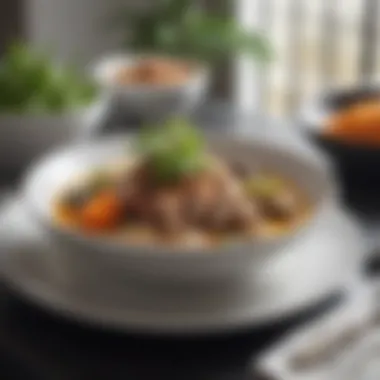Culinary Insights from The Slanted Door Cookbook


Intro
The Slanted Door Cookbook serves as a gateway to a rich, aromatic world of Vietnamese cuisine, emphasizing the necessity of time efficiency in cooking. With a myriad of vibrant colors and bold flavors, this cookbook goes beyond conventional recipes. It seamlessly integrates key culinary techniques that enable busy individuals to create meals full of life without excessive time commitment.
By reflecting on the origins of the cookbook and its philosophy, the reader gains insight into how it caters to modern lifestyles while respecting traditional culinary practices. The subsequent sections will open a window into the flavor-packed recipes it contains, delving into their accessibility and unique characteristics. Expect detailed cooking instructions and nutritional information designed for both novice and experienced cooks.
There's no doubt this cookbook positions itself meaningfully within today’s culinary landscape as it presents pragmatic approaches to bringing Vietnamese flavors to your dining table.
Recipe Overview
The recipes in The Slanted Door Cookbook are exceptional and tailored for those with busy schedules. Consider the iconic Vietnamese Grilled Pork Skewers for a delightful culinary experiment.
- Number of Portions: Yields 4
- Time Required: 30 minutes for prep, 20 minutes for cooking
- Difficulty: Medium
- Main Ingredients: Pork tenderloin, fish sauce, sugar, garlic, lemongrass, and black pepper
Step-by-Step Instructions
- Prep Ingredients: Slice the pork into uniform pieces for even cooking. In a bowl, combine fish sauce, sugar, minced garlic, chopped lemongrass, and black pepper.
- Marinate: Add the pork to the marinade and let it sit for at least 15 minutes, allowing flavors to penetrate the meat.
- Skewer: Thread the marinated pork onto skewers. If using wooden skewers, soak them in water first to prevent burning.
- Cook: Grill skewers over high heat for about 6-8 minutes on each side. Look for a nice caramelization on the pork.
- Serve: Plate with a side of fresh herbs and lettuce for wrapping.
Integrating techniques that save time while maximizing flavor is key in today’s cooking.
Nutritional Information
For every serving of the pork skewers, one can expect:
- Total Calories: 250
- Proteins: 30g
- Fats: 12g
- Carbohydrates: 3g
This dish offers beneficial nutrients such as vitamin A from greens and protein-rich pork, bringing additional value to meals.
Quick Cooking Tips
- Utilizing Gadgets: An air fryer can speed up the cooking process without lasciaing taste. Place skewers in the air fryer for even cooking with less oill.
- Multitasking: While marinating, chop vegetables for garnish or prepare a quick sauce. This efficiency enhances the meal experience.
- Substitutions: Chicken or tofu can easily replace pork for vegan options, ensuring versatility in dietary needs.
Related Recipes & Variations
Elevate the meal by serving alongside Vietnamese Salad Rolls or Spicy Lemongrass Soup. Versions of the skewers can cater to dietary restrictions using:
- Gluten-free soy sauce
- Plant-based proteins like tempeh
Inviting readers to experiment with their takes makes cooking more interactive and personal. The joy of cooking can be a shared journey, infusing tradition with modern demands.
Prelude to The Slanted Door Cookbook
The Slanted Door Cookbook serves as a vital resource for both amateur and seasoned cooks. It represents a blend of culinary tradition and modern efficiency, appealing particularly to those with a demanding lifestyle. As we delve into this cooking guide, we can identify key themes and notable influences woven throughout its recipes. Understanding its importance provides context not just to the dishes themselves, but to the evolving landscape of home cooking and dietary needs.
Background and Inspiration
The inspiration behind The Slanted Door Cookbook grows from a desire to articulate Vietnamese culinary artistry while making it accessible to a broader audience. Ingredients like fresh herbs, bold condiments, and balanced flavors define Vietnamese cuisine. The authors, inspired by their cultural roots and experiences, curate a collection of recipes that echo their culinary heritage while embracing local and seasonal components. This dedication not only honors Vietnamese traditions but also sparks a new conversation around sustainable cooking.
Moreover, the cookbook builds on the premise that busy individuals still desire taste and quality in their meals. Each recipe invites experimentation and adaptation, emphasizing that good food does not have to take hours to prepare. In this way, it allows for personal expression as cooks can tailor dishes to their preferences.
Authors and Their Culinary Philosophy


The authors of The Slanted Door Cookbook, Charles Phan and his collaborators, embody a distinct culinary philosophy. They emphasize a commitment to ingredient quality and vivid flavors. This philosophy is particularly aimed at enhancing everyday dining experiences. The book projects an approach that combines imagination and creativity with time-tested techniques.
At the core of their philosophy is the belief that cooking should be fun and not burdensome. They guide readers with practical techniques that increase efficiency without sacrificing flavor. By fostering a connection to the food and its relief that any dish can elevate daily routines, the authors position the act of cooking as a gratifying endeavor instead of a chore.
“Cooking is love made visible,” Phan suggests, reminding readers that meals can bring people together.
As we explore the content of The Slanted Door Cookbook, it becomes clear that the culinary journey starts with understanding these roots. Thus, appreciating the backgrounds of those crafting these recipes enhances one's experience and inspires a greater appreciation for the philosophy they embody.
Core Themes of the Cookbook
The core themes of The Slanted Door Cookbook are crucial in understanding its approach to modern cooking. Instead of simply offering recipes, this cookbook emphasizes simplicity, seasonality, and Vietnamese culinary traditions. Each of these themes contributes to a greater culinary experience that aligns with contemporary demands for efficiency and enjoyment in cooking.
Simplicity in Cooking
One prominent theme is simplicity. The Slanted Door Cookbook adopts a philosophy that champions straightforward culinary techniques. The book is designed for individuals who may not have extensive cooking backgrounds but want delicious results.
The focus on whole, easily recognizable ingredients is essential. By limiting complex preparations, each dish shines in its own right, minimizing cooking time while maximizing flavor potential. Recipes often require minimal tools and intermediate steps are kept to a minimum. This adherence to simplicity makes the cooking process less daunting, encouraging more people to embrace home-cooked meals.
Furthermore, simplicity does not equate to lack of sophistication. On the contrary, it allows for a focus on essential flavors. Ingredients are celebrated rather than masked. This connection to fundamental cooking principles aids in fostering a deeper appreciation for both cooking and eating.
Seasonality and Fresh Ingredients
Another integral theme is the emphasis on seasonality and fresh ingredients. The cookbook pushes the importance of using ingredients at their peak ripeness. This influences not only flavor but nutrition as well. As a result, these recipes cultivate awareness about food sourcing and seasonal buying habits.
Adapting recipes according to what is available in local markets enhances creativity in the kitchen. Using fresh produce in season can lead to diminished grocery costs while providing the best flavors. When vegetables and fruits are fresh, they contribute vibrant colors, inviting textures, and outstanding authenticity to dishes.
- Benefits:
- Enhanced flavor profile
- Increased nutritional value
- Cost-effectiveness when local produce is used
Cookbook enthusiasts can create meals that reflect a respect for the environment, encouraging a sustainable approach to cooking. Therefore, integrating seasonal ingredients becomes not just a trend, but a fundamental aspect of mindful eating.
Vietnamese Influences
The third defining theme centers on Vietnamese influences. The Slanted Door Cookbook showcases dishes that reflect the rich tapestry of Vietnamese culinary traditions. Ingredients such as fish sauce, lemongrass, and fresh herbs blend harmoniously, transforming simple preparations into exciting delicacies.
The cookbook captures this cultural narrative fully, illustrating how traditional techniques and flavors can seamlessly intersect with modern dining requirements. Each recipe serves as a bridge between the past and present, allowing home cooks to engage with ancient traditions while adapting them to everyday life.
Vietnamese food, known for balance, uses ample herbs and spices. This is evident as it encourages aromatic combinations. The balance between savory and sweet is essential, making dishes reliable yet unexpectedly delightful with each forkful.
In summary, the core themes of The Slanted Door Cookbook — simplicity, seasonality, and Vietnamese influences — contribute to its status as a relevant resource in today’s culinary landscape. These aspects work in harmony to create a sense of ease and creativity in the kitchen, ensuring that cooking remains not just a necessity, but also a pleasure.
Exploring Key Recipes
Exploring the key recipes in The Slanted Door Cookbook is essential because it showcases the heart of the culinary journey within its pages. For many, recipes serve as a bridge to experiences, flavors, and memories. The selection of appetizers, main dishes, and desserts reflects not just the ingredients but also the techniques and philosophy behind Vietnamese cuisine. Engaging with these recipes can inspire home cooks to embrace their creativity while also achieving culinary efficiency, a hallmark of contemporary cooking.
Appetizers and Small Plates
The section of appetizers and small plates in this cookbook offers a diverse array of options that highlight the importance of balancing flavor with presentation. Dishes such as Spring Rolls with Peanut Sauce and Fried Tofu with Tangy Dipping Sauce allow ingredients to shine through simple yet refined techniques. These recipes are notable for inviting individualization; small plates encourage experimentation with substitutions and variations, suitable for those feeling dictated by their busyness.
By emphasizing easy, flavorful, and visually appealing appetizers, this section helps set the tone for gatherings or as starters for a larger meal. Furthermore, the focus on fresh vegetables exemplifies the contributions of Vietnamese food principles, often revolving around vibrant and fresh tastes. Preparing these dishes can promote a faster pace in meal preparation without sacrificing quality or taste.


Main Dishes
Main dishes within The Slanted Door Cookbook present the core of mealtime experiences. Options like Crispy Rice Cake with Crab or Braised Pork Belly with Coconut Soda model the intersection between tradition and modern interpretive cooking. Here, the techniques are not overly elaborate but nonetheless provide depth and satisfaction.
What makes this section particularly significant is the careful selection of proteins and vegetables, emphasizing sustainability and seasonality. Adopting these principles explains the cookbook’s focus on sourcing ingredients that appear in harmony with the home-cook philosophy, connecting meal preparation with environmental consciousness. These main courses not only comfort the palate but encourage mindful eating.
Desserts
Lastly, the dessert section cannot be overlooked. Desserts offer a moment of reflection on sweetness and indulgence without excessive complexity. Recipes such as Mango Sticky Rice and Coconut Pudding with Fruit highlight simple elements requiring minimal preparation while providing an inherent sophistication.
Engaging with these flavors prompts the realization that desserts in Vietnamese cooking lean towards the natural sugars of fruits rather than refined sugars. This approach creates a satisfying finish to a meal that resonates with maintaining a healthy balance. Desserts ultimately serve as a testament to the overall culinary journey the cookbook presents, illustrating creativity and consideration for health.
By engaging with these key recipes, home cooks can discover flavor without complexity, merging culinary art with efficiency.
In synthesis, the integral aspect of The Slanted Door Cookbook lies sophisticatedly entwined within these key recipes. As culinary enthusiasts explore each category, the principles become tangible, allowing readers to infuse aspects of Vietnamese cooking into their home kitchens while meeting the demands of modern life.
Techniques and Tips for Home Cooks
The significance of practical knowledge for home cooks cannot be overstated. When it comes to navigating the diverse recipes found in The Slanted Door Cookbook, well-informed techniques and smart cooking tips elevate the culinary experience. Efficient methods can simplify otherwise intricate dishes, thereby making them accessible. This internal dialogue between technique and food preparation enriches one's culinary life.
Essential Cooking Techniques
To appreciate the recipes from The Slanted Door, one must first grasp the essential cooking techniques discussed within its pages. These are not merely instructions for preparation; they serve as a foundation that underpins every meal you create.
Key Techniques
- Knife Skills: Mastering how to wield a knife properly streamlines the entire cooking process. Good chopping, mincing, or slicing minimizes prep time and enhances flavor release.
- Sautéing: This quick and essential technique emphasizes the vital role of oil and high heat, resulting in texture without overwhelming ingredients.
- Marinating: A seemingly simple step that magnifies flavor. It's about understanding how ingredients like acid attract and interact with food.
By gaining competency in these vital skills, you tap into the true essence of each recipe, allowing for flexibility while cooking.
Time-Saving Cooking Methods
Despite the rich flavors and complexity that can emerge from The Slanted Door, many daily cooks require practical strategies to streamline their kitchen endeavors. Time-saving strategies lend a hand without sacrificing quality.
Effective Practices
- Prep in Batches: Prepare staples like sauces and sides multiple times on weekends. This preparation lightens the load on busy weeknights.
- One-Pot Recipes: Look for recipes that emphasize minimal dish use. These enable flavor amalgamation while consolidating your clean-up efforts.
- Tech Tools: Investment in tools, like food processors or slow cookers, pays dividends in time management. These devices allow for remarkable multipurpose use within the cooking realm.
A key takeaway: embracing efficiency in the kitchen does not lessen the joy of cooking but enhances it, paving the way for gastronomic exploration amidst a bustling lifestyle.
Efficient techniques are the gateway to a more enjoyable and less stressful cooking experience, allowing time for creativity.
Adapting Recipes for a Busy Lifestyle
In today's fast-paced environment, cooking can often feel like a burdensome chore rather than an enjoyable activity. The Slanted Door Cookbook recognizes this challenge. Its emphasis on adapting recipes for busy lifestyles is essential. Busy individuals want efficiency but do not want to nature lost in flavors and aromas of cooking. By presenting time-efficient methods, the cookbook allows cooks to balance daily responsibilities with the need for nutritious and satisfying meals.
Key aspects include:
- Flexibility in recipe adaptation: Recipes can often be adjusted based on available ingredients and time constraints. Flexibility not only saves time but also encourages creativity.
- Nutritional Integrity: The cookbook emphasizes that quick meals can still be healthful. Shortcuts in cooking shouldn't come at the cost of nutrition.
- Engagement: Adapting recipes supports a more engaged cooking experience. Instead of merely following instructions, cooks can make recipes their own. This not only enhances mastery of cooking but also develops a personal connection to the food.
Batch Cooking Strategies


Batch cooking is a time-saving strategy that can transform how individuals approach their weekly meals. It involves preparing food in large quantities upfront. This method serves multiple purposes. Cooking once allows recipes to be repurposed and provides diverse meal options throughout the week.
Some key strategies include:
- Plan Ahead: Spend time each week organizing recipes and shopping lists. A clear plan will enhance the efficiency of batch cooking.
- Choose Versatile Dishes: Select recipes that can be used across multiple meals. Dishes like stir-fries or soups are excellent for this purpose, as they can seamlessly transition into lunches or dinners the next day.
- Proper Storage: Use clear containers for easily identifiable portions. Freeze meals that can be stored over longer periods, preventing wastage and making future meal prep a breeze.
Adopting batch cooking strategies can greatly lessen the stress of weekday meals, allowing individuals to focus on enjoying time in the kitchen rather than being overwhelmed by it.
Making Use of Leftovers
Utilizing leftovers is an intelligent way to minimize food waste and streamline meal preparation. The Slanted Door Cookbook provides inspiration on how to repurpose leftover ingredients effectively. Instead of viewing leftovers as simply uneaten food from previous meals, they can be seen as opportunities.
Here are some practical considerations:
- Creative Combinations: Leftovers can be transformed into new dishes. For instance, roasted vegetables from dinner can find new life in omelets or grain salads.
- Flavor Development: Utilizing what's already cooked reduces the need for extensive meal building each day. Not to mention, reusing ingredients can enhance flavors once combined, making for richer tastes.
- Time Optimization: Using leftovers cuts the time spent on food preparation. This aspect ties perfectly to our busy lifestyles today, allowing quick meals with minimal post-cooking effort.
Leftover use extends the life of ingredients and supports enjoyable, budget-friendly cooking. Embracing both batch cooking and clever repurposing of leftovers solidifies the Slanted Door's commitment to efficiency, bringing ease and inspiration into daily culinary practices.
Integrating The Slanted Door Cookbook into Daily Cooking
Integrating the recipes and techniques from The Slanted Door Cookbook into daily cooking is essential for anyone looking to elevate their culinary experience while maintaining practicality. This section delves into the benefits of regularly utilizing this cookbook. By embracing its approaches, home cooks can make informed choices. Daily cooking should be enjoyable and manageable, where flavors are not compromised by time constraints.
The cookbook emphasizes adaptable recipes using accessible ingredients. This makes the integration process simpler. Readers can leverage the different elements of the book to create meals suitable for their everyday lives. Alongside this, the essence of Vietnamese culinary philosophy encapsulated within its pages instills a deeper understanding of flavors, all while ensuring cooking remains efficient.
Weekly Meal Planning
Weekly meal planning is a cornerstone of successful culinary integration. Understanding how to coordinate meals means avoiding the overwhelming nature of last-minute cooking. The Slanted Door Cookbook provides varied recipes, which can appeal to taste buds while fitting into a received schedule.
A disciplined meal planning approach can result in notable advantages:
- Encourages experimentation with different cuisines, specifically Vietnamese.
- Reduces stress often associated with daily cooking tasks.
- Saves money by minimizing food waste through strategic ingredient usage.
Using The Slanted Door Cookbook, one can cultivate a meal plan that includes different categories: Appetizers, Main Dishes, and Desserts. This variety ensures that meals never feel redundant. Setting aside a time to plan the week's menu sharpens cooking skills and encourages creativity.
Cooking for Families
Cooking for families often requires striking a balance between nutrition, flavor, and convenience. The Slanted Door Cookbook aligns perfectly with this need. Its emphasis on fresh ingredients resonates with busy schedules while still appealing to family members of all ages. Including all, from picky eaters to adventurous culinary explorers, fosters a love of cooking while reducing mealtime battles.
Consider these strategies to cater effectively to family member preferences:
- Engage the family. Involve kids in the meal preparation process.
- Highlight community traditions from Vietnamese culture. This conformation fosters a sense of unity during meals.
- Opt for recipes that are modifiable. Customize your recipes to suit everyone’s taste.
The integration of The Slanted Door Cookbook not only makes cooking efficient but also strengthens family bonds around the dinner table. Recipes designed for families reflect nutrition without compromising on flavor, delivering happy moments through shared meals.
“Cooking is an activity that both feeds the body and strengthens family connections.”
Closure
The exploration of The Slanted Door Cookbook reveals its significance beyond simply a collection of recipes. Its impact moulds the way one approaches the culinary arts, particularly for those traversing a busy lifestyle. The discussion around the melding of efficiency with rich flavor accents the advantages the book brings to modern cooking.
The Lasting Impact of The Slanted Door
The Slanted Door creates a link between traditional Vietnamese cooking and contemporary fast-paced living. This resonate messaging encourages cooks, both novice and seasoned, to embrace simplicity while maintaining the integrity of flavours. The influences stem from the depth of Vietnamese culinary heritage spoken through each dish. Through this cookbook, readers gain insight into not just how to prepare a meal but also appreciate the cultural significance behind ingredients. It makes one realize that engaging with food can be both a practical and enriching experience. As a staple for culinary enthusiasts, The Slanted Door encourages an evolution towards cooking that feels both comfortable and inspired. Article suggested further ~~read more~~ to understand the origins and influences.
Final Thoughts on Culinary Exploration
Culinary exploration encourages an appreciation for unique tastes amid the cacophony of daily routines. Food serves as both sustenance and an avenue for creativity. In the context of The Slanted Door Cookbook, it offers straightforward techniques and adaptable recipes that broaden a reader's understanding while allowing them to experiment within their home kitchen. Those interested in exploring Vietnamese flavours and robust culinary practices can find empowerment in this shifting landscape of food expression.
Ultimately, The Slanted Door Cookbook invites readers not just to follow recipes, but to engage in a journey where each dish connects history, culture, and everyday practicality. This connection to food breeds a sense of community and shared experience in the kitchen. Hence, the pursuit of culinary knowledge thus continues beyond the pages, transforming the everyday into spectacular when food finds its purpose in the realm of human connection.







